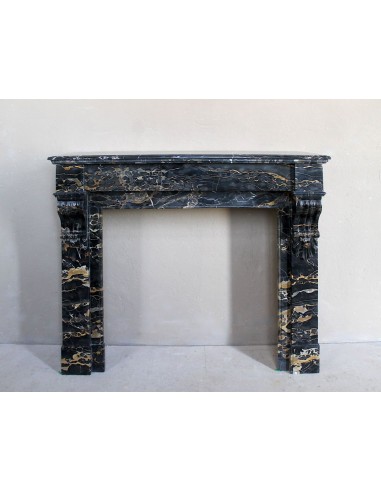Are you looking for a fireplace that is super pretty, super antique, super right in size and maybe even ... super rich?
Well, then this "boy" of a fireplace will really do the trick....
He's a good-looking guy, the serious kind like only once there was, he's slim of waist, he's got a nice lean physique and, why not, he's also got a noble profile...
And a handsome profile, since a fireplace happens to look at it from the side as well, not just the front...) will look good at your hall.
Going back to the initial discussion, why do I say that this fireplace is a boy?
But because fireplaces are divided, like humans, into the two canonical sexes, male and female..
Male are the styles belonging to the great Neoclassical family, such as Louis XVI, Empire, Directoire or, as in our case, Louis Philippe..
The male, in fact, has more straight, linear and even somewhat serious lines..
The females are all in Baroque styles, such as Louis XV (the more procubescent ones) or Louis XIV (the “manager” type, a little less exuberant than their Louis XV cousins, in short..), or Regency, all styles in which the ninety-degree angle is abolished.. ...
The female, in fact, must (or else it's a problem, isn't it?!) have firm curves and soft, possibly sensuous, lines.. It will be easy for you to understand this difference between the sexes of fireplaces by taking a little tour of my site, in the sections, precisely, of the styles mentioned above..
And you will immediately understand the difference there is between male and female fireplaces...
Of course, even in the sex of fireplaces we have a few exceptions, a few “borderline” mantels (they are the only words I know in English, besides yes..), a few fireplaces that can be called “bisexual,” but here the speech would be too long and I don't want to bore you, maybe we will talk about it in another and more appropriate situation...
That little lecture on the sex of antique fireplaces done, let's come to our Palmettes....
HE, has the slabs all, save of course the leafy carvings of his capitals, with smooth surfaces, square corners, poise, in short, rather serious, without stylistic excesses, and this, how shall we say, resigned attitude of his, is given by the fact that, after all, HE strikes us and amazes us with the fabric of his marble dress, a PORTORO marble of great quality, indeed, of the highest quality. Here I think it is good to explain why our fireplace, seemingly “simple,” with no architectural flights of fancy, has been dressed in such an important and, what many imagine, also very expensive PORTORO marble.. Well, this marble today is extremely expensive (indeed, something more, Portoro GOLD is now THE most valuable marble in the world) but once upon a time our Portoro was quarried in abundance and the difference between the finest and scarcest choice was VERY limited... TODAY, since quarrying has been over for half a century, small lots of this quality of Portoro can be found on the market and whoever has them, sells them very dearly, we have now reached a price of € 1000 per square meter (mind you, we are talking about a 2 cm thick slab, eh, not about thicker “blocks”..
It was born, our male mantel, in the period 1840/60 about the time that saw Italy united, much to the chagrin of Bossi and heirs, it was carved to be placed in a bedroom, and this turns out to be most convenient for us, since our little rooms (which some still insist on calling “salons”..) since our little rooms, I was saying, have increasingly smaller measurements (perhaps like the ancient bedrooms) and therefore require unobtrusive fireplaces (as our mantel is) in terms of measurements.
LOUIS PHILIPPE "PALMETTES” FIREPLACE MANTEL IN PORTORO GOLD MARBLE, 1840-60S ERA, PERFECTLY PRESERVED, PARISIAN PROVENANCE.












































































